Conflict Resolution in Nursing: Clinical Workplace Experience Report
VerifiedAdded on 2023/01/10
|13
|3657
|50
Report
AI Summary
This report details a nursing student's experience with a conflict situation in a clinical setting involving a patient, a general practitioner, and the nursing team. The student, working as an enrolled nurse, encountered a disagreement regarding medication administration, prompting the application of leadership and management skills. The student utilized transformational leadership, delegating tasks based on team member competencies, and employed interpersonal communication and collaboration to resolve the conflict. The report highlights the importance of evidence-based practice, cultural competence, and patient-centered communication in resolving the conflict, which involved addressing a patient's concerns and ensuring the patient's needs were met. The student's actions led to a positive outcome, fostering teamwork and improved patient care. The report also discusses the application of NMBA standards of practice to ensure patient safety and ethical care.
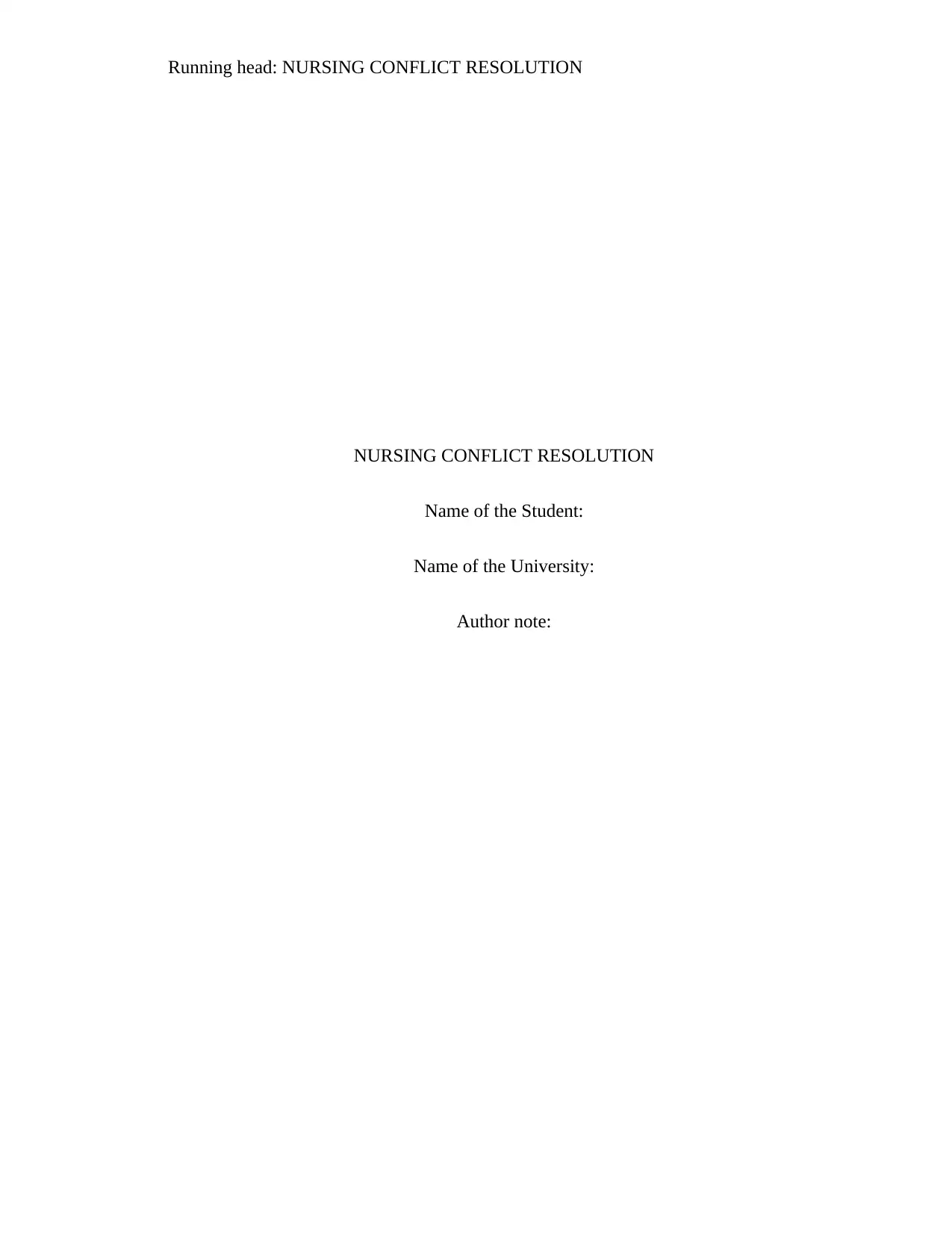
Running head: NURSING CONFLICT RESOLUTION
NURSING CONFLICT RESOLUTION
Name of the Student:
Name of the University:
Author note:
NURSING CONFLICT RESOLUTION
Name of the Student:
Name of the University:
Author note:
Secure Best Marks with AI Grader
Need help grading? Try our AI Grader for instant feedback on your assignments.
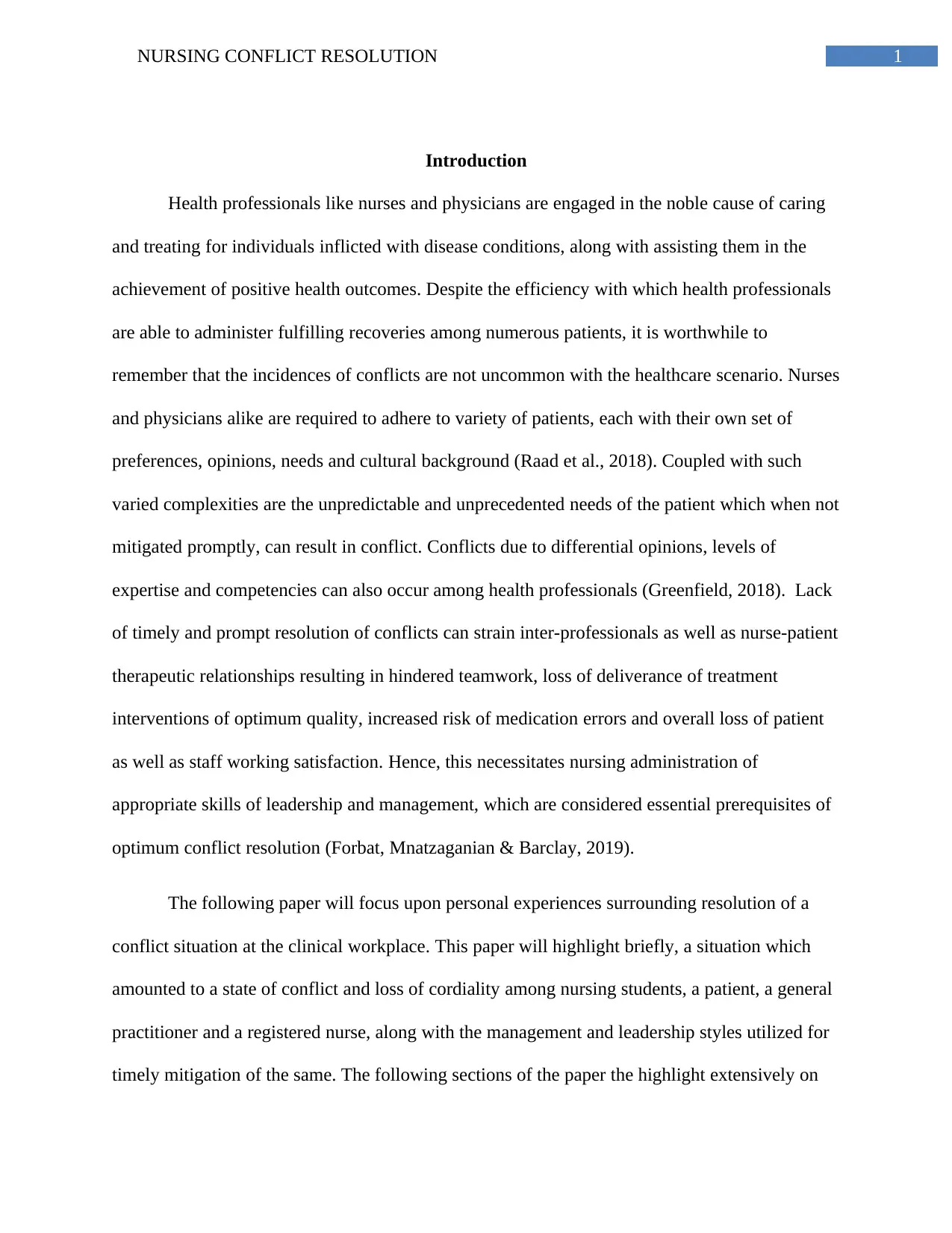
1NURSING CONFLICT RESOLUTION
Introduction
Health professionals like nurses and physicians are engaged in the noble cause of caring
and treating for individuals inflicted with disease conditions, along with assisting them in the
achievement of positive health outcomes. Despite the efficiency with which health professionals
are able to administer fulfilling recoveries among numerous patients, it is worthwhile to
remember that the incidences of conflicts are not uncommon with the healthcare scenario. Nurses
and physicians alike are required to adhere to variety of patients, each with their own set of
preferences, opinions, needs and cultural background (Raad et al., 2018). Coupled with such
varied complexities are the unpredictable and unprecedented needs of the patient which when not
mitigated promptly, can result in conflict. Conflicts due to differential opinions, levels of
expertise and competencies can also occur among health professionals (Greenfield, 2018). Lack
of timely and prompt resolution of conflicts can strain inter-professionals as well as nurse-patient
therapeutic relationships resulting in hindered teamwork, loss of deliverance of treatment
interventions of optimum quality, increased risk of medication errors and overall loss of patient
as well as staff working satisfaction. Hence, this necessitates nursing administration of
appropriate skills of leadership and management, which are considered essential prerequisites of
optimum conflict resolution (Forbat, Mnatzaganian & Barclay, 2019).
The following paper will focus upon personal experiences surrounding resolution of a
conflict situation at the clinical workplace. This paper will highlight briefly, a situation which
amounted to a state of conflict and loss of cordiality among nursing students, a patient, a general
practitioner and a registered nurse, along with the management and leadership styles utilized for
timely mitigation of the same. The following sections of the paper the highlight extensively on
Introduction
Health professionals like nurses and physicians are engaged in the noble cause of caring
and treating for individuals inflicted with disease conditions, along with assisting them in the
achievement of positive health outcomes. Despite the efficiency with which health professionals
are able to administer fulfilling recoveries among numerous patients, it is worthwhile to
remember that the incidences of conflicts are not uncommon with the healthcare scenario. Nurses
and physicians alike are required to adhere to variety of patients, each with their own set of
preferences, opinions, needs and cultural background (Raad et al., 2018). Coupled with such
varied complexities are the unpredictable and unprecedented needs of the patient which when not
mitigated promptly, can result in conflict. Conflicts due to differential opinions, levels of
expertise and competencies can also occur among health professionals (Greenfield, 2018). Lack
of timely and prompt resolution of conflicts can strain inter-professionals as well as nurse-patient
therapeutic relationships resulting in hindered teamwork, loss of deliverance of treatment
interventions of optimum quality, increased risk of medication errors and overall loss of patient
as well as staff working satisfaction. Hence, this necessitates nursing administration of
appropriate skills of leadership and management, which are considered essential prerequisites of
optimum conflict resolution (Forbat, Mnatzaganian & Barclay, 2019).
The following paper will focus upon personal experiences surrounding resolution of a
conflict situation at the clinical workplace. This paper will highlight briefly, a situation which
amounted to a state of conflict and loss of cordiality among nursing students, a patient, a general
practitioner and a registered nurse, along with the management and leadership styles utilized for
timely mitigation of the same. The following sections of the paper the highlight extensively on
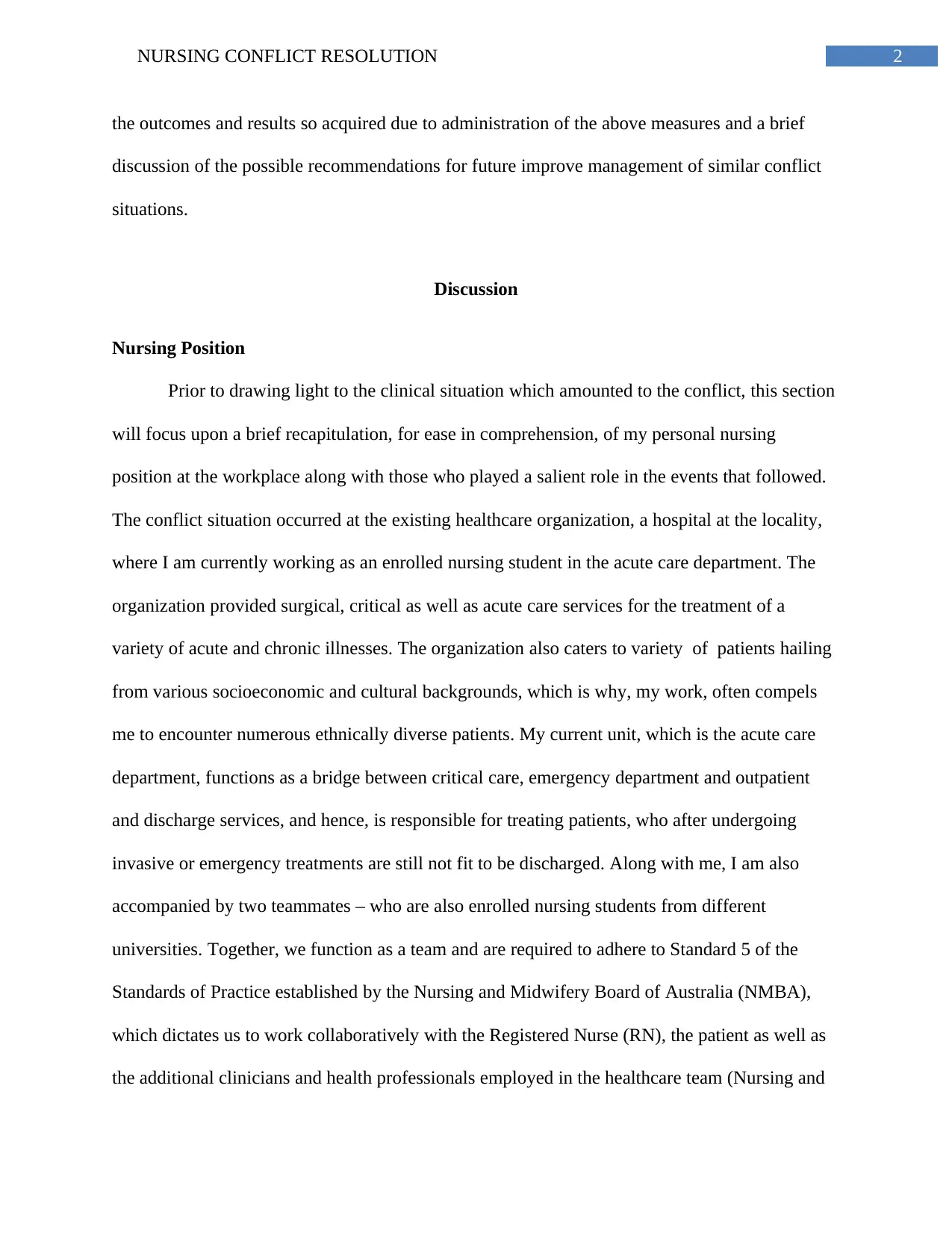
2NURSING CONFLICT RESOLUTION
the outcomes and results so acquired due to administration of the above measures and a brief
discussion of the possible recommendations for future improve management of similar conflict
situations.
Discussion
Nursing Position
Prior to drawing light to the clinical situation which amounted to the conflict, this section
will focus upon a brief recapitulation, for ease in comprehension, of my personal nursing
position at the workplace along with those who played a salient role in the events that followed.
The conflict situation occurred at the existing healthcare organization, a hospital at the locality,
where I am currently working as an enrolled nursing student in the acute care department. The
organization provided surgical, critical as well as acute care services for the treatment of a
variety of acute and chronic illnesses. The organization also caters to variety of patients hailing
from various socioeconomic and cultural backgrounds, which is why, my work, often compels
me to encounter numerous ethnically diverse patients. My current unit, which is the acute care
department, functions as a bridge between critical care, emergency department and outpatient
and discharge services, and hence, is responsible for treating patients, who after undergoing
invasive or emergency treatments are still not fit to be discharged. Along with me, I am also
accompanied by two teammates – who are also enrolled nursing students from different
universities. Together, we function as a team and are required to adhere to Standard 5 of the
Standards of Practice established by the Nursing and Midwifery Board of Australia (NMBA),
which dictates us to work collaboratively with the Registered Nurse (RN), the patient as well as
the additional clinicians and health professionals employed in the healthcare team (Nursing and
the outcomes and results so acquired due to administration of the above measures and a brief
discussion of the possible recommendations for future improve management of similar conflict
situations.
Discussion
Nursing Position
Prior to drawing light to the clinical situation which amounted to the conflict, this section
will focus upon a brief recapitulation, for ease in comprehension, of my personal nursing
position at the workplace along with those who played a salient role in the events that followed.
The conflict situation occurred at the existing healthcare organization, a hospital at the locality,
where I am currently working as an enrolled nursing student in the acute care department. The
organization provided surgical, critical as well as acute care services for the treatment of a
variety of acute and chronic illnesses. The organization also caters to variety of patients hailing
from various socioeconomic and cultural backgrounds, which is why, my work, often compels
me to encounter numerous ethnically diverse patients. My current unit, which is the acute care
department, functions as a bridge between critical care, emergency department and outpatient
and discharge services, and hence, is responsible for treating patients, who after undergoing
invasive or emergency treatments are still not fit to be discharged. Along with me, I am also
accompanied by two teammates – who are also enrolled nursing students from different
universities. Together, we function as a team and are required to adhere to Standard 5 of the
Standards of Practice established by the Nursing and Midwifery Board of Australia (NMBA),
which dictates us to work collaboratively with the Registered Nurse (RN), the patient as well as
the additional clinicians and health professionals employed in the healthcare team (Nursing and
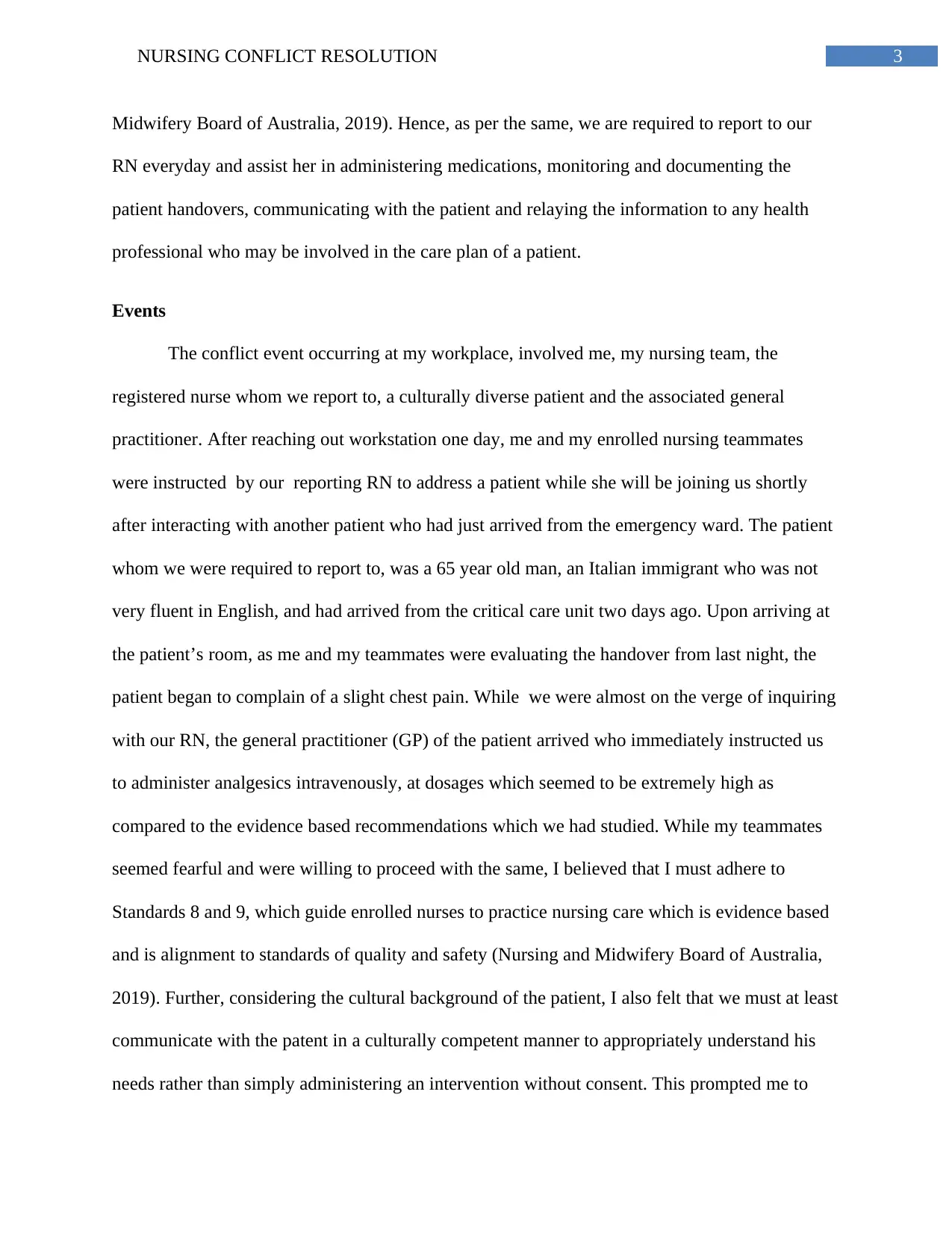
3NURSING CONFLICT RESOLUTION
Midwifery Board of Australia, 2019). Hence, as per the same, we are required to report to our
RN everyday and assist her in administering medications, monitoring and documenting the
patient handovers, communicating with the patient and relaying the information to any health
professional who may be involved in the care plan of a patient.
Events
The conflict event occurring at my workplace, involved me, my nursing team, the
registered nurse whom we report to, a culturally diverse patient and the associated general
practitioner. After reaching out workstation one day, me and my enrolled nursing teammates
were instructed by our reporting RN to address a patient while she will be joining us shortly
after interacting with another patient who had just arrived from the emergency ward. The patient
whom we were required to report to, was a 65 year old man, an Italian immigrant who was not
very fluent in English, and had arrived from the critical care unit two days ago. Upon arriving at
the patient’s room, as me and my teammates were evaluating the handover from last night, the
patient began to complain of a slight chest pain. While we were almost on the verge of inquiring
with our RN, the general practitioner (GP) of the patient arrived who immediately instructed us
to administer analgesics intravenously, at dosages which seemed to be extremely high as
compared to the evidence based recommendations which we had studied. While my teammates
seemed fearful and were willing to proceed with the same, I believed that I must adhere to
Standards 8 and 9, which guide enrolled nurses to practice nursing care which is evidence based
and is alignment to standards of quality and safety (Nursing and Midwifery Board of Australia,
2019). Further, considering the cultural background of the patient, I also felt that we must at least
communicate with the patent in a culturally competent manner to appropriately understand his
needs rather than simply administering an intervention without consent. This prompted me to
Midwifery Board of Australia, 2019). Hence, as per the same, we are required to report to our
RN everyday and assist her in administering medications, monitoring and documenting the
patient handovers, communicating with the patient and relaying the information to any health
professional who may be involved in the care plan of a patient.
Events
The conflict event occurring at my workplace, involved me, my nursing team, the
registered nurse whom we report to, a culturally diverse patient and the associated general
practitioner. After reaching out workstation one day, me and my enrolled nursing teammates
were instructed by our reporting RN to address a patient while she will be joining us shortly
after interacting with another patient who had just arrived from the emergency ward. The patient
whom we were required to report to, was a 65 year old man, an Italian immigrant who was not
very fluent in English, and had arrived from the critical care unit two days ago. Upon arriving at
the patient’s room, as me and my teammates were evaluating the handover from last night, the
patient began to complain of a slight chest pain. While we were almost on the verge of inquiring
with our RN, the general practitioner (GP) of the patient arrived who immediately instructed us
to administer analgesics intravenously, at dosages which seemed to be extremely high as
compared to the evidence based recommendations which we had studied. While my teammates
seemed fearful and were willing to proceed with the same, I believed that I must adhere to
Standards 8 and 9, which guide enrolled nurses to practice nursing care which is evidence based
and is alignment to standards of quality and safety (Nursing and Midwifery Board of Australia,
2019). Further, considering the cultural background of the patient, I also felt that we must at least
communicate with the patent in a culturally competent manner to appropriately understand his
needs rather than simply administering an intervention without consent. This prompted me to
Secure Best Marks with AI Grader
Need help grading? Try our AI Grader for instant feedback on your assignments.
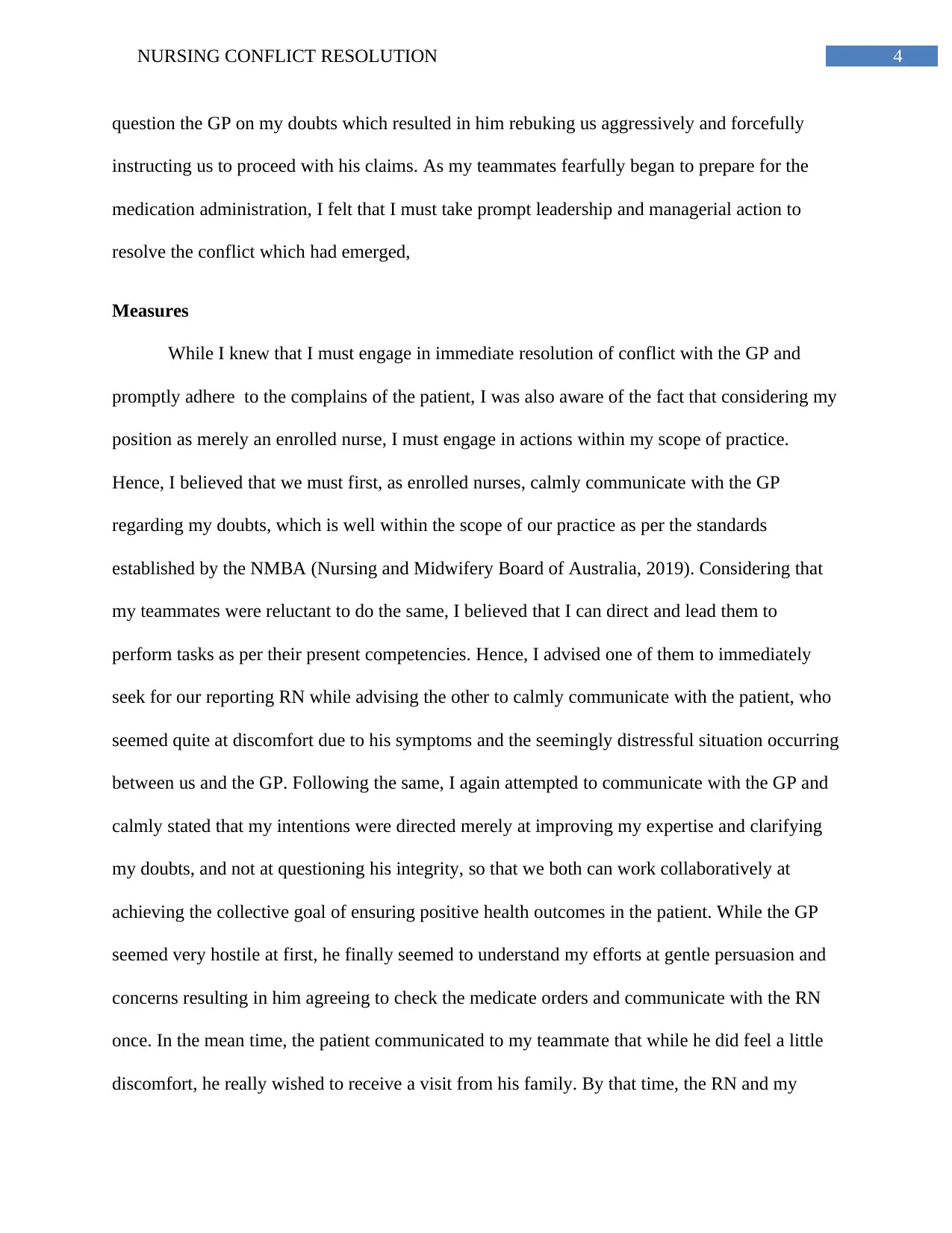
4NURSING CONFLICT RESOLUTION
question the GP on my doubts which resulted in him rebuking us aggressively and forcefully
instructing us to proceed with his claims. As my teammates fearfully began to prepare for the
medication administration, I felt that I must take prompt leadership and managerial action to
resolve the conflict which had emerged,
Measures
While I knew that I must engage in immediate resolution of conflict with the GP and
promptly adhere to the complains of the patient, I was also aware of the fact that considering my
position as merely an enrolled nurse, I must engage in actions within my scope of practice.
Hence, I believed that we must first, as enrolled nurses, calmly communicate with the GP
regarding my doubts, which is well within the scope of our practice as per the standards
established by the NMBA (Nursing and Midwifery Board of Australia, 2019). Considering that
my teammates were reluctant to do the same, I believed that I can direct and lead them to
perform tasks as per their present competencies. Hence, I advised one of them to immediately
seek for our reporting RN while advising the other to calmly communicate with the patient, who
seemed quite at discomfort due to his symptoms and the seemingly distressful situation occurring
between us and the GP. Following the same, I again attempted to communicate with the GP and
calmly stated that my intentions were directed merely at improving my expertise and clarifying
my doubts, and not at questioning his integrity, so that we both can work collaboratively at
achieving the collective goal of ensuring positive health outcomes in the patient. While the GP
seemed very hostile at first, he finally seemed to understand my efforts at gentle persuasion and
concerns resulting in him agreeing to check the medicate orders and communicate with the RN
once. In the mean time, the patient communicated to my teammate that while he did feel a little
discomfort, he really wished to receive a visit from his family. By that time, the RN and my
question the GP on my doubts which resulted in him rebuking us aggressively and forcefully
instructing us to proceed with his claims. As my teammates fearfully began to prepare for the
medication administration, I felt that I must take prompt leadership and managerial action to
resolve the conflict which had emerged,
Measures
While I knew that I must engage in immediate resolution of conflict with the GP and
promptly adhere to the complains of the patient, I was also aware of the fact that considering my
position as merely an enrolled nurse, I must engage in actions within my scope of practice.
Hence, I believed that we must first, as enrolled nurses, calmly communicate with the GP
regarding my doubts, which is well within the scope of our practice as per the standards
established by the NMBA (Nursing and Midwifery Board of Australia, 2019). Considering that
my teammates were reluctant to do the same, I believed that I can direct and lead them to
perform tasks as per their present competencies. Hence, I advised one of them to immediately
seek for our reporting RN while advising the other to calmly communicate with the patient, who
seemed quite at discomfort due to his symptoms and the seemingly distressful situation occurring
between us and the GP. Following the same, I again attempted to communicate with the GP and
calmly stated that my intentions were directed merely at improving my expertise and clarifying
my doubts, and not at questioning his integrity, so that we both can work collaboratively at
achieving the collective goal of ensuring positive health outcomes in the patient. While the GP
seemed very hostile at first, he finally seemed to understand my efforts at gentle persuasion and
concerns resulting in him agreeing to check the medicate orders and communicate with the RN
once. In the mean time, the patient communicated to my teammate that while he did feel a little
discomfort, he really wished to receive a visit from his family. By that time, the RN and my
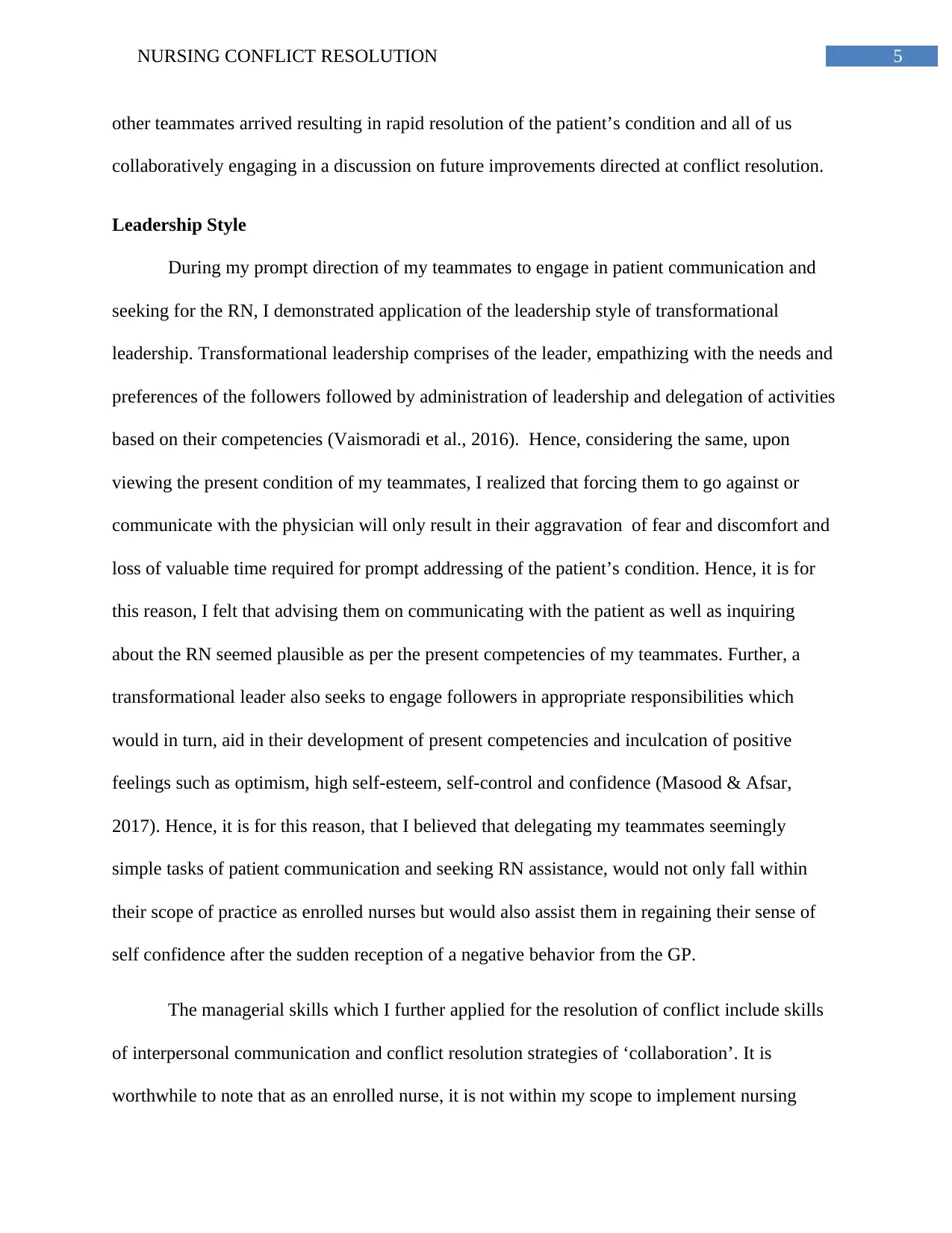
5NURSING CONFLICT RESOLUTION
other teammates arrived resulting in rapid resolution of the patient’s condition and all of us
collaboratively engaging in a discussion on future improvements directed at conflict resolution.
Leadership Style
During my prompt direction of my teammates to engage in patient communication and
seeking for the RN, I demonstrated application of the leadership style of transformational
leadership. Transformational leadership comprises of the leader, empathizing with the needs and
preferences of the followers followed by administration of leadership and delegation of activities
based on their competencies (Vaismoradi et al., 2016). Hence, considering the same, upon
viewing the present condition of my teammates, I realized that forcing them to go against or
communicate with the physician will only result in their aggravation of fear and discomfort and
loss of valuable time required for prompt addressing of the patient’s condition. Hence, it is for
this reason, I felt that advising them on communicating with the patient as well as inquiring
about the RN seemed plausible as per the present competencies of my teammates. Further, a
transformational leader also seeks to engage followers in appropriate responsibilities which
would in turn, aid in their development of present competencies and inculcation of positive
feelings such as optimism, high self-esteem, self-control and confidence (Masood & Afsar,
2017). Hence, it is for this reason, that I believed that delegating my teammates seemingly
simple tasks of patient communication and seeking RN assistance, would not only fall within
their scope of practice as enrolled nurses but would also assist them in regaining their sense of
self confidence after the sudden reception of a negative behavior from the GP.
The managerial skills which I further applied for the resolution of conflict include skills
of interpersonal communication and conflict resolution strategies of ‘collaboration’. It is
worthwhile to note that as an enrolled nurse, it is not within my scope to implement nursing
other teammates arrived resulting in rapid resolution of the patient’s condition and all of us
collaboratively engaging in a discussion on future improvements directed at conflict resolution.
Leadership Style
During my prompt direction of my teammates to engage in patient communication and
seeking for the RN, I demonstrated application of the leadership style of transformational
leadership. Transformational leadership comprises of the leader, empathizing with the needs and
preferences of the followers followed by administration of leadership and delegation of activities
based on their competencies (Vaismoradi et al., 2016). Hence, considering the same, upon
viewing the present condition of my teammates, I realized that forcing them to go against or
communicate with the physician will only result in their aggravation of fear and discomfort and
loss of valuable time required for prompt addressing of the patient’s condition. Hence, it is for
this reason, I felt that advising them on communicating with the patient as well as inquiring
about the RN seemed plausible as per the present competencies of my teammates. Further, a
transformational leader also seeks to engage followers in appropriate responsibilities which
would in turn, aid in their development of present competencies and inculcation of positive
feelings such as optimism, high self-esteem, self-control and confidence (Masood & Afsar,
2017). Hence, it is for this reason, that I believed that delegating my teammates seemingly
simple tasks of patient communication and seeking RN assistance, would not only fall within
their scope of practice as enrolled nurses but would also assist them in regaining their sense of
self confidence after the sudden reception of a negative behavior from the GP.
The managerial skills which I further applied for the resolution of conflict include skills
of interpersonal communication and conflict resolution strategies of ‘collaboration’. It is
worthwhile to note that as an enrolled nurse, it is not within my scope to implement nursing
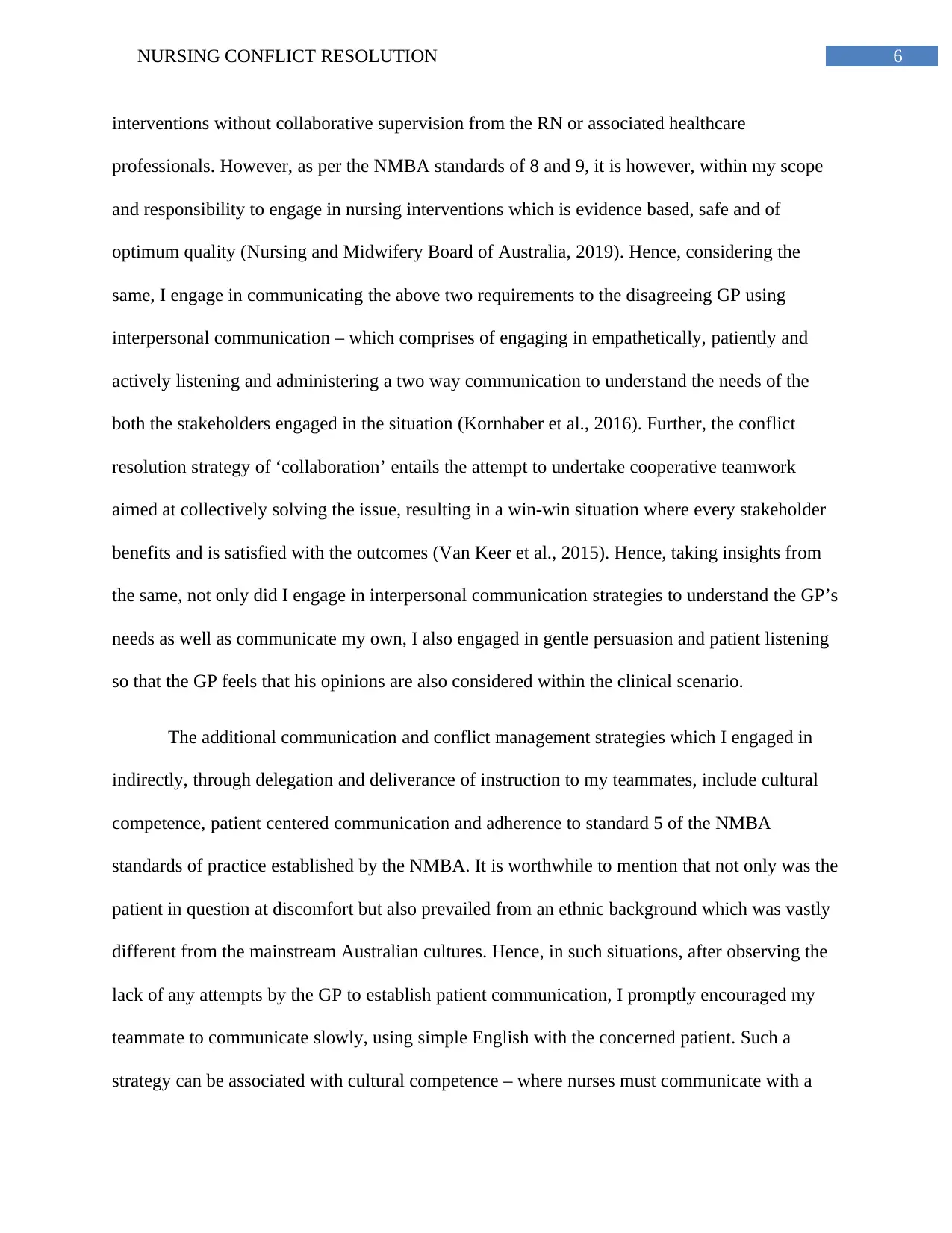
6NURSING CONFLICT RESOLUTION
interventions without collaborative supervision from the RN or associated healthcare
professionals. However, as per the NMBA standards of 8 and 9, it is however, within my scope
and responsibility to engage in nursing interventions which is evidence based, safe and of
optimum quality (Nursing and Midwifery Board of Australia, 2019). Hence, considering the
same, I engage in communicating the above two requirements to the disagreeing GP using
interpersonal communication – which comprises of engaging in empathetically, patiently and
actively listening and administering a two way communication to understand the needs of the
both the stakeholders engaged in the situation (Kornhaber et al., 2016). Further, the conflict
resolution strategy of ‘collaboration’ entails the attempt to undertake cooperative teamwork
aimed at collectively solving the issue, resulting in a win-win situation where every stakeholder
benefits and is satisfied with the outcomes (Van Keer et al., 2015). Hence, taking insights from
the same, not only did I engage in interpersonal communication strategies to understand the GP’s
needs as well as communicate my own, I also engaged in gentle persuasion and patient listening
so that the GP feels that his opinions are also considered within the clinical scenario.
The additional communication and conflict management strategies which I engaged in
indirectly, through delegation and deliverance of instruction to my teammates, include cultural
competence, patient centered communication and adherence to standard 5 of the NMBA
standards of practice established by the NMBA. It is worthwhile to mention that not only was the
patient in question at discomfort but also prevailed from an ethnic background which was vastly
different from the mainstream Australian cultures. Hence, in such situations, after observing the
lack of any attempts by the GP to establish patient communication, I promptly encouraged my
teammate to communicate slowly, using simple English with the concerned patient. Such a
strategy can be associated with cultural competence – where nurses must communicate with a
interventions without collaborative supervision from the RN or associated healthcare
professionals. However, as per the NMBA standards of 8 and 9, it is however, within my scope
and responsibility to engage in nursing interventions which is evidence based, safe and of
optimum quality (Nursing and Midwifery Board of Australia, 2019). Hence, considering the
same, I engage in communicating the above two requirements to the disagreeing GP using
interpersonal communication – which comprises of engaging in empathetically, patiently and
actively listening and administering a two way communication to understand the needs of the
both the stakeholders engaged in the situation (Kornhaber et al., 2016). Further, the conflict
resolution strategy of ‘collaboration’ entails the attempt to undertake cooperative teamwork
aimed at collectively solving the issue, resulting in a win-win situation where every stakeholder
benefits and is satisfied with the outcomes (Van Keer et al., 2015). Hence, taking insights from
the same, not only did I engage in interpersonal communication strategies to understand the GP’s
needs as well as communicate my own, I also engaged in gentle persuasion and patient listening
so that the GP feels that his opinions are also considered within the clinical scenario.
The additional communication and conflict management strategies which I engaged in
indirectly, through delegation and deliverance of instruction to my teammates, include cultural
competence, patient centered communication and adherence to standard 5 of the NMBA
standards of practice established by the NMBA. It is worthwhile to mention that not only was the
patient in question at discomfort but also prevailed from an ethnic background which was vastly
different from the mainstream Australian cultures. Hence, in such situations, after observing the
lack of any attempts by the GP to establish patient communication, I promptly encouraged my
teammate to communicate slowly, using simple English with the concerned patient. Such a
strategy can be associated with cultural competence – where nurses must communicate with a
Paraphrase This Document
Need a fresh take? Get an instant paraphrase of this document with our AI Paraphraser
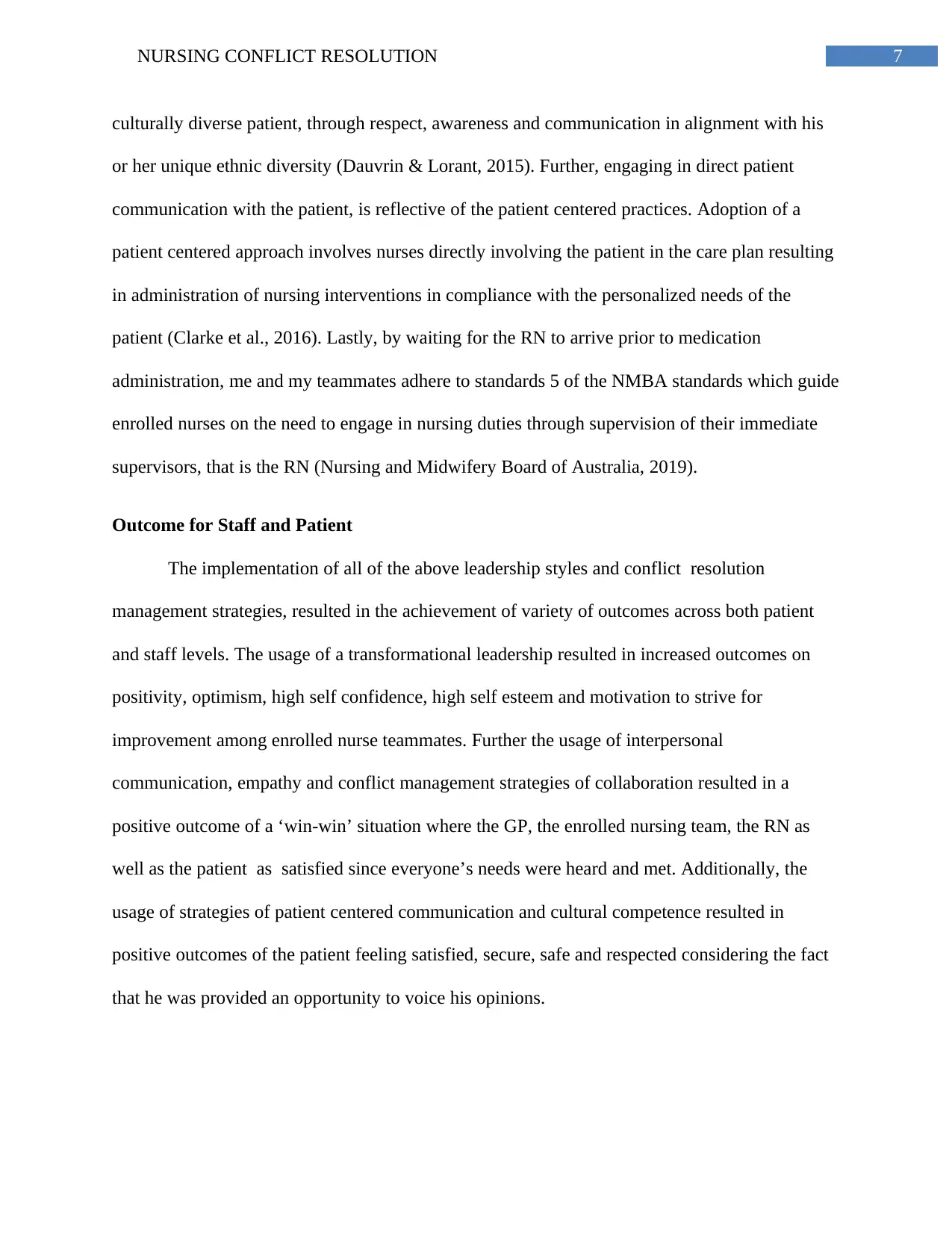
7NURSING CONFLICT RESOLUTION
culturally diverse patient, through respect, awareness and communication in alignment with his
or her unique ethnic diversity (Dauvrin & Lorant, 2015). Further, engaging in direct patient
communication with the patient, is reflective of the patient centered practices. Adoption of a
patient centered approach involves nurses directly involving the patient in the care plan resulting
in administration of nursing interventions in compliance with the personalized needs of the
patient (Clarke et al., 2016). Lastly, by waiting for the RN to arrive prior to medication
administration, me and my teammates adhere to standards 5 of the NMBA standards which guide
enrolled nurses on the need to engage in nursing duties through supervision of their immediate
supervisors, that is the RN (Nursing and Midwifery Board of Australia, 2019).
Outcome for Staff and Patient
The implementation of all of the above leadership styles and conflict resolution
management strategies, resulted in the achievement of variety of outcomes across both patient
and staff levels. The usage of a transformational leadership resulted in increased outcomes on
positivity, optimism, high self confidence, high self esteem and motivation to strive for
improvement among enrolled nurse teammates. Further the usage of interpersonal
communication, empathy and conflict management strategies of collaboration resulted in a
positive outcome of a ‘win-win’ situation where the GP, the enrolled nursing team, the RN as
well as the patient as satisfied since everyone’s needs were heard and met. Additionally, the
usage of strategies of patient centered communication and cultural competence resulted in
positive outcomes of the patient feeling satisfied, secure, safe and respected considering the fact
that he was provided an opportunity to voice his opinions.
culturally diverse patient, through respect, awareness and communication in alignment with his
or her unique ethnic diversity (Dauvrin & Lorant, 2015). Further, engaging in direct patient
communication with the patient, is reflective of the patient centered practices. Adoption of a
patient centered approach involves nurses directly involving the patient in the care plan resulting
in administration of nursing interventions in compliance with the personalized needs of the
patient (Clarke et al., 2016). Lastly, by waiting for the RN to arrive prior to medication
administration, me and my teammates adhere to standards 5 of the NMBA standards which guide
enrolled nurses on the need to engage in nursing duties through supervision of their immediate
supervisors, that is the RN (Nursing and Midwifery Board of Australia, 2019).
Outcome for Staff and Patient
The implementation of all of the above leadership styles and conflict resolution
management strategies, resulted in the achievement of variety of outcomes across both patient
and staff levels. The usage of a transformational leadership resulted in increased outcomes on
positivity, optimism, high self confidence, high self esteem and motivation to strive for
improvement among enrolled nurse teammates. Further the usage of interpersonal
communication, empathy and conflict management strategies of collaboration resulted in a
positive outcome of a ‘win-win’ situation where the GP, the enrolled nursing team, the RN as
well as the patient as satisfied since everyone’s needs were heard and met. Additionally, the
usage of strategies of patient centered communication and cultural competence resulted in
positive outcomes of the patient feeling satisfied, secure, safe and respected considering the fact
that he was provided an opportunity to voice his opinions.
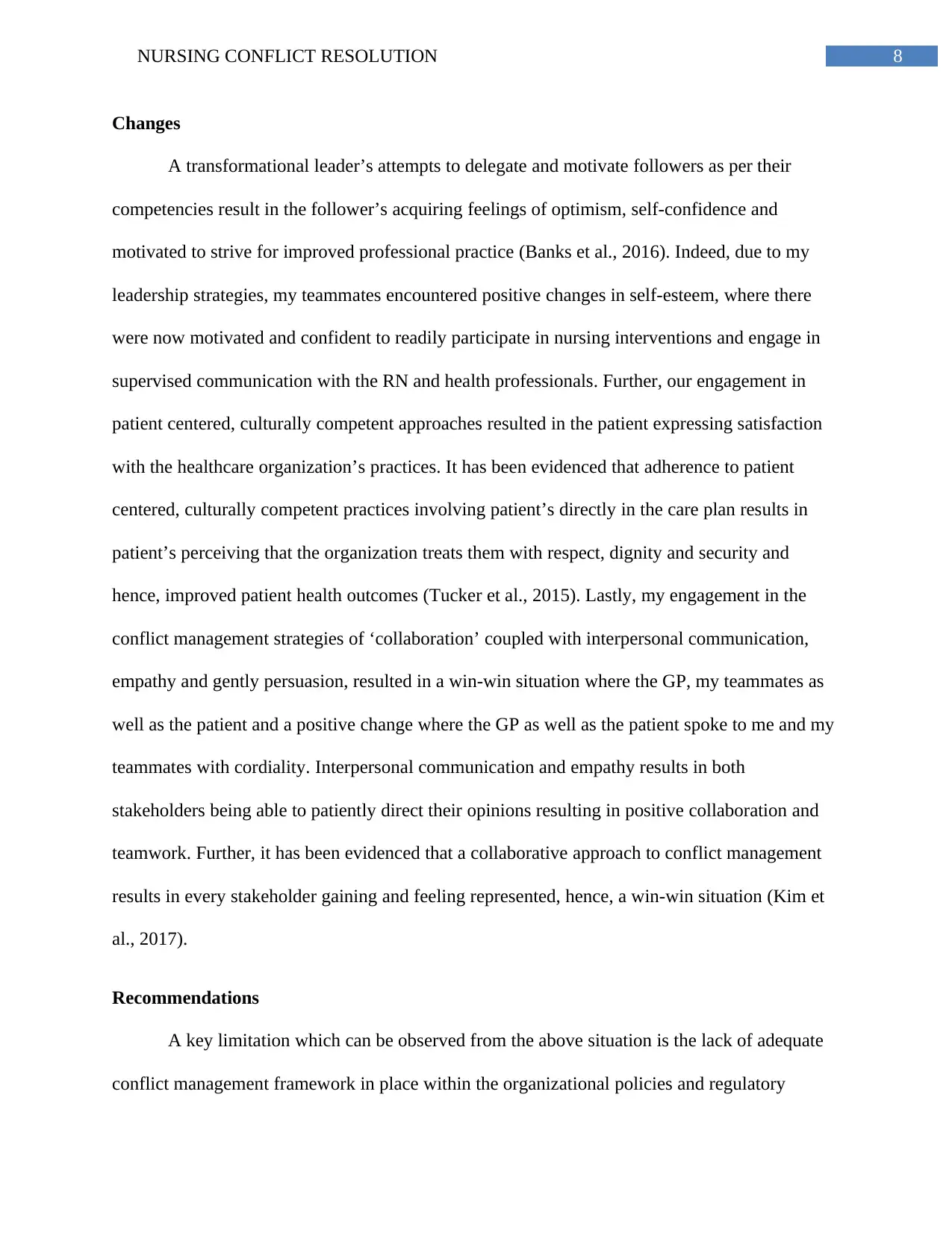
8NURSING CONFLICT RESOLUTION
Changes
A transformational leader’s attempts to delegate and motivate followers as per their
competencies result in the follower’s acquiring feelings of optimism, self-confidence and
motivated to strive for improved professional practice (Banks et al., 2016). Indeed, due to my
leadership strategies, my teammates encountered positive changes in self-esteem, where there
were now motivated and confident to readily participate in nursing interventions and engage in
supervised communication with the RN and health professionals. Further, our engagement in
patient centered, culturally competent approaches resulted in the patient expressing satisfaction
with the healthcare organization’s practices. It has been evidenced that adherence to patient
centered, culturally competent practices involving patient’s directly in the care plan results in
patient’s perceiving that the organization treats them with respect, dignity and security and
hence, improved patient health outcomes (Tucker et al., 2015). Lastly, my engagement in the
conflict management strategies of ‘collaboration’ coupled with interpersonal communication,
empathy and gently persuasion, resulted in a win-win situation where the GP, my teammates as
well as the patient and a positive change where the GP as well as the patient spoke to me and my
teammates with cordiality. Interpersonal communication and empathy results in both
stakeholders being able to patiently direct their opinions resulting in positive collaboration and
teamwork. Further, it has been evidenced that a collaborative approach to conflict management
results in every stakeholder gaining and feeling represented, hence, a win-win situation (Kim et
al., 2017).
Recommendations
A key limitation which can be observed from the above situation is the lack of adequate
conflict management framework in place within the organizational policies and regulatory
Changes
A transformational leader’s attempts to delegate and motivate followers as per their
competencies result in the follower’s acquiring feelings of optimism, self-confidence and
motivated to strive for improved professional practice (Banks et al., 2016). Indeed, due to my
leadership strategies, my teammates encountered positive changes in self-esteem, where there
were now motivated and confident to readily participate in nursing interventions and engage in
supervised communication with the RN and health professionals. Further, our engagement in
patient centered, culturally competent approaches resulted in the patient expressing satisfaction
with the healthcare organization’s practices. It has been evidenced that adherence to patient
centered, culturally competent practices involving patient’s directly in the care plan results in
patient’s perceiving that the organization treats them with respect, dignity and security and
hence, improved patient health outcomes (Tucker et al., 2015). Lastly, my engagement in the
conflict management strategies of ‘collaboration’ coupled with interpersonal communication,
empathy and gently persuasion, resulted in a win-win situation where the GP, my teammates as
well as the patient and a positive change where the GP as well as the patient spoke to me and my
teammates with cordiality. Interpersonal communication and empathy results in both
stakeholders being able to patiently direct their opinions resulting in positive collaboration and
teamwork. Further, it has been evidenced that a collaborative approach to conflict management
results in every stakeholder gaining and feeling represented, hence, a win-win situation (Kim et
al., 2017).
Recommendations
A key limitation which can be observed from the above situation is the lack of adequate
conflict management framework in place within the organizational policies and regulatory
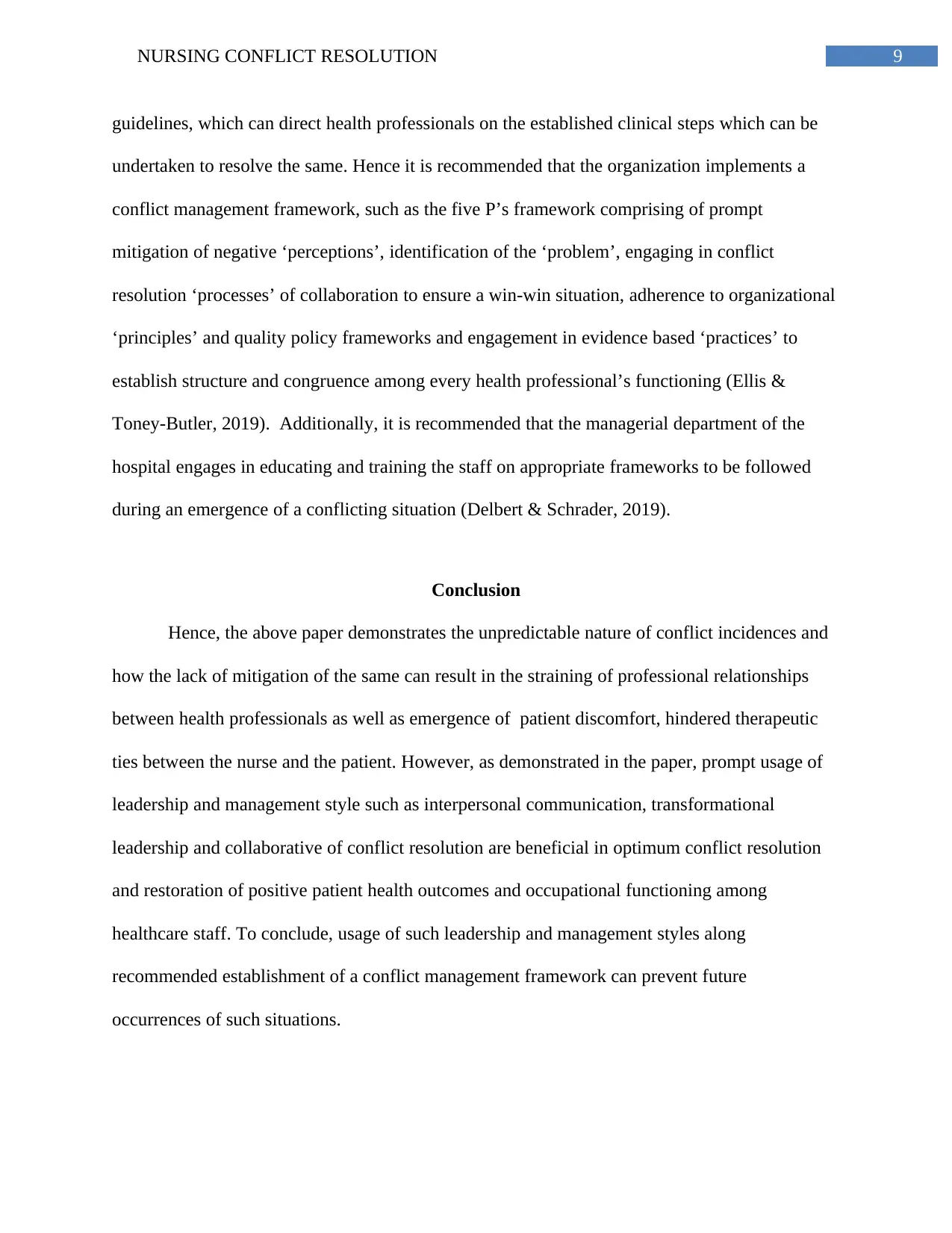
9NURSING CONFLICT RESOLUTION
guidelines, which can direct health professionals on the established clinical steps which can be
undertaken to resolve the same. Hence it is recommended that the organization implements a
conflict management framework, such as the five P’s framework comprising of prompt
mitigation of negative ‘perceptions’, identification of the ‘problem’, engaging in conflict
resolution ‘processes’ of collaboration to ensure a win-win situation, adherence to organizational
‘principles’ and quality policy frameworks and engagement in evidence based ‘practices’ to
establish structure and congruence among every health professional’s functioning (Ellis &
Toney-Butler, 2019). Additionally, it is recommended that the managerial department of the
hospital engages in educating and training the staff on appropriate frameworks to be followed
during an emergence of a conflicting situation (Delbert & Schrader, 2019).
Conclusion
Hence, the above paper demonstrates the unpredictable nature of conflict incidences and
how the lack of mitigation of the same can result in the straining of professional relationships
between health professionals as well as emergence of patient discomfort, hindered therapeutic
ties between the nurse and the patient. However, as demonstrated in the paper, prompt usage of
leadership and management style such as interpersonal communication, transformational
leadership and collaborative of conflict resolution are beneficial in optimum conflict resolution
and restoration of positive patient health outcomes and occupational functioning among
healthcare staff. To conclude, usage of such leadership and management styles along
recommended establishment of a conflict management framework can prevent future
occurrences of such situations.
guidelines, which can direct health professionals on the established clinical steps which can be
undertaken to resolve the same. Hence it is recommended that the organization implements a
conflict management framework, such as the five P’s framework comprising of prompt
mitigation of negative ‘perceptions’, identification of the ‘problem’, engaging in conflict
resolution ‘processes’ of collaboration to ensure a win-win situation, adherence to organizational
‘principles’ and quality policy frameworks and engagement in evidence based ‘practices’ to
establish structure and congruence among every health professional’s functioning (Ellis &
Toney-Butler, 2019). Additionally, it is recommended that the managerial department of the
hospital engages in educating and training the staff on appropriate frameworks to be followed
during an emergence of a conflicting situation (Delbert & Schrader, 2019).
Conclusion
Hence, the above paper demonstrates the unpredictable nature of conflict incidences and
how the lack of mitigation of the same can result in the straining of professional relationships
between health professionals as well as emergence of patient discomfort, hindered therapeutic
ties between the nurse and the patient. However, as demonstrated in the paper, prompt usage of
leadership and management style such as interpersonal communication, transformational
leadership and collaborative of conflict resolution are beneficial in optimum conflict resolution
and restoration of positive patient health outcomes and occupational functioning among
healthcare staff. To conclude, usage of such leadership and management styles along
recommended establishment of a conflict management framework can prevent future
occurrences of such situations.
Secure Best Marks with AI Grader
Need help grading? Try our AI Grader for instant feedback on your assignments.
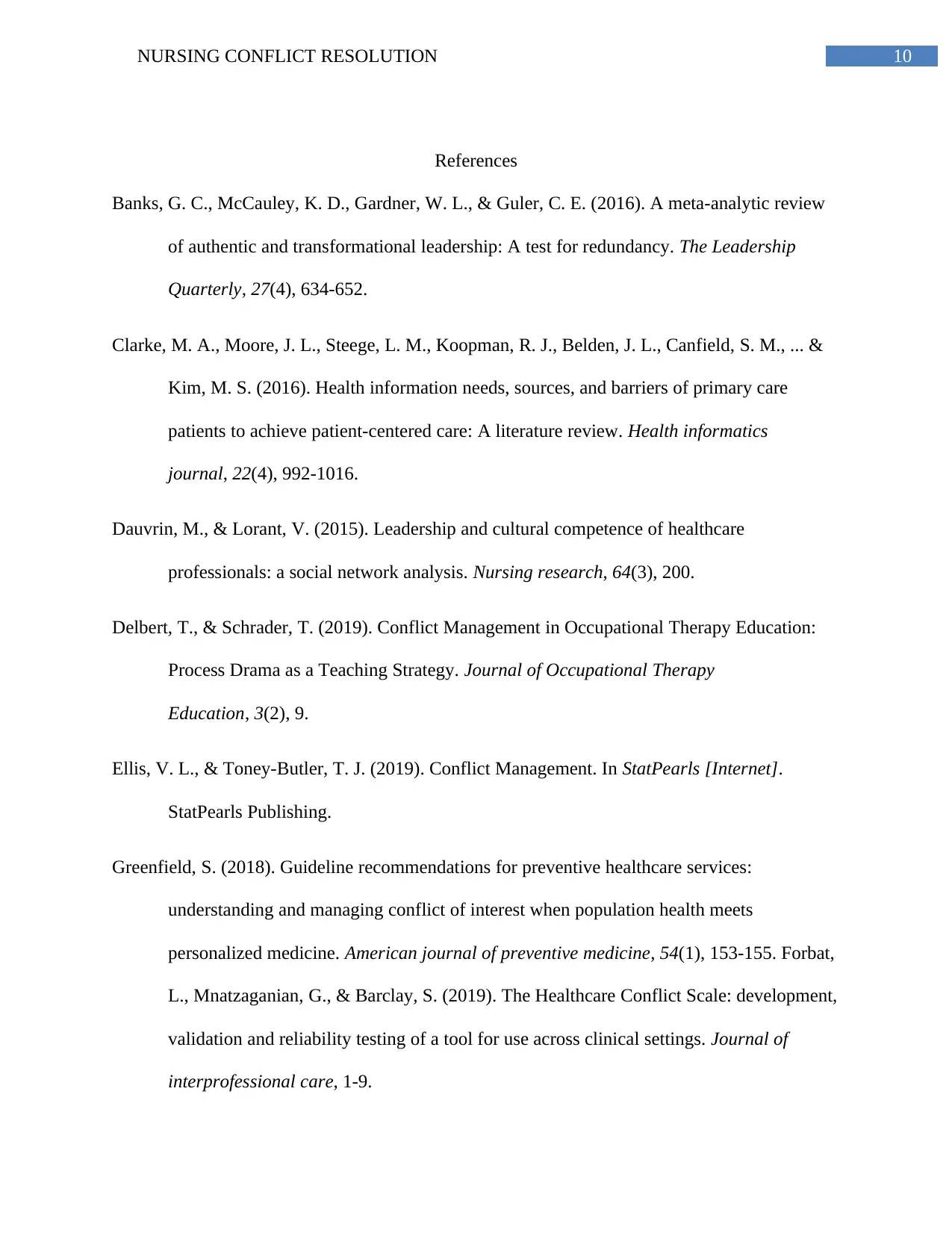
10NURSING CONFLICT RESOLUTION
References
Banks, G. C., McCauley, K. D., Gardner, W. L., & Guler, C. E. (2016). A meta-analytic review
of authentic and transformational leadership: A test for redundancy. The Leadership
Quarterly, 27(4), 634-652.
Clarke, M. A., Moore, J. L., Steege, L. M., Koopman, R. J., Belden, J. L., Canfield, S. M., ... &
Kim, M. S. (2016). Health information needs, sources, and barriers of primary care
patients to achieve patient-centered care: A literature review. Health informatics
journal, 22(4), 992-1016.
Dauvrin, M., & Lorant, V. (2015). Leadership and cultural competence of healthcare
professionals: a social network analysis. Nursing research, 64(3), 200.
Delbert, T., & Schrader, T. (2019). Conflict Management in Occupational Therapy Education:
Process Drama as a Teaching Strategy. Journal of Occupational Therapy
Education, 3(2), 9.
Ellis, V. L., & Toney-Butler, T. J. (2019). Conflict Management. In StatPearls [Internet].
StatPearls Publishing.
Greenfield, S. (2018). Guideline recommendations for preventive healthcare services:
understanding and managing conflict of interest when population health meets
personalized medicine. American journal of preventive medicine, 54(1), 153-155. Forbat,
L., Mnatzaganian, G., & Barclay, S. (2019). The Healthcare Conflict Scale: development,
validation and reliability testing of a tool for use across clinical settings. Journal of
interprofessional care, 1-9.
References
Banks, G. C., McCauley, K. D., Gardner, W. L., & Guler, C. E. (2016). A meta-analytic review
of authentic and transformational leadership: A test for redundancy. The Leadership
Quarterly, 27(4), 634-652.
Clarke, M. A., Moore, J. L., Steege, L. M., Koopman, R. J., Belden, J. L., Canfield, S. M., ... &
Kim, M. S. (2016). Health information needs, sources, and barriers of primary care
patients to achieve patient-centered care: A literature review. Health informatics
journal, 22(4), 992-1016.
Dauvrin, M., & Lorant, V. (2015). Leadership and cultural competence of healthcare
professionals: a social network analysis. Nursing research, 64(3), 200.
Delbert, T., & Schrader, T. (2019). Conflict Management in Occupational Therapy Education:
Process Drama as a Teaching Strategy. Journal of Occupational Therapy
Education, 3(2), 9.
Ellis, V. L., & Toney-Butler, T. J. (2019). Conflict Management. In StatPearls [Internet].
StatPearls Publishing.
Greenfield, S. (2018). Guideline recommendations for preventive healthcare services:
understanding and managing conflict of interest when population health meets
personalized medicine. American journal of preventive medicine, 54(1), 153-155. Forbat,
L., Mnatzaganian, G., & Barclay, S. (2019). The Healthcare Conflict Scale: development,
validation and reliability testing of a tool for use across clinical settings. Journal of
interprofessional care, 1-9.
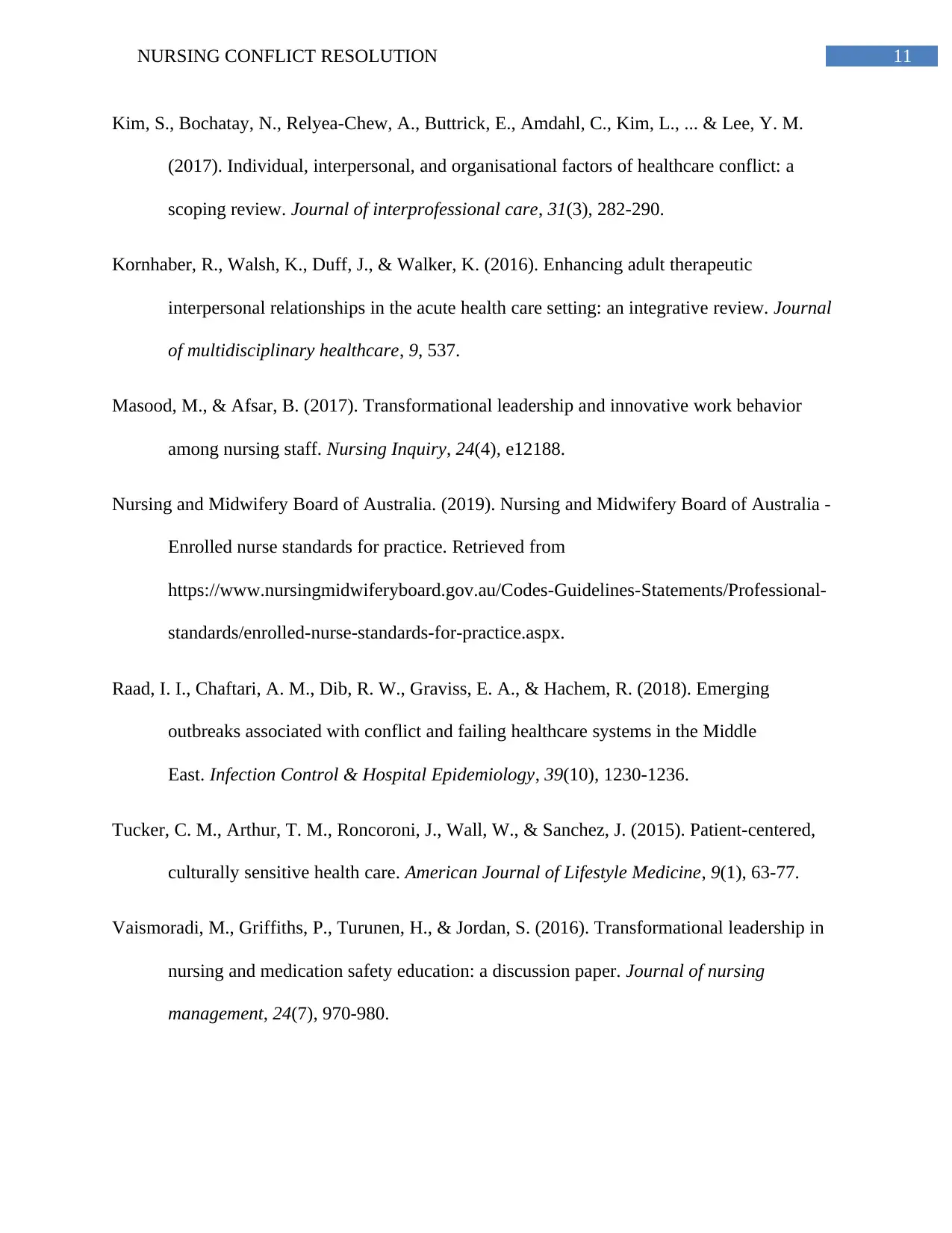
11NURSING CONFLICT RESOLUTION
Kim, S., Bochatay, N., Relyea-Chew, A., Buttrick, E., Amdahl, C., Kim, L., ... & Lee, Y. M.
(2017). Individual, interpersonal, and organisational factors of healthcare conflict: a
scoping review. Journal of interprofessional care, 31(3), 282-290.
Kornhaber, R., Walsh, K., Duff, J., & Walker, K. (2016). Enhancing adult therapeutic
interpersonal relationships in the acute health care setting: an integrative review. Journal
of multidisciplinary healthcare, 9, 537.
Masood, M., & Afsar, B. (2017). Transformational leadership and innovative work behavior
among nursing staff. Nursing Inquiry, 24(4), e12188.
Nursing and Midwifery Board of Australia. (2019). Nursing and Midwifery Board of Australia -
Enrolled nurse standards for practice. Retrieved from
https://www.nursingmidwiferyboard.gov.au/Codes-Guidelines-Statements/Professional-
standards/enrolled-nurse-standards-for-practice.aspx.
Raad, I. I., Chaftari, A. M., Dib, R. W., Graviss, E. A., & Hachem, R. (2018). Emerging
outbreaks associated with conflict and failing healthcare systems in the Middle
East. Infection Control & Hospital Epidemiology, 39(10), 1230-1236.
Tucker, C. M., Arthur, T. M., Roncoroni, J., Wall, W., & Sanchez, J. (2015). Patient-centered,
culturally sensitive health care. American Journal of Lifestyle Medicine, 9(1), 63-77.
Vaismoradi, M., Griffiths, P., Turunen, H., & Jordan, S. (2016). Transformational leadership in
nursing and medication safety education: a discussion paper. Journal of nursing
management, 24(7), 970-980.
Kim, S., Bochatay, N., Relyea-Chew, A., Buttrick, E., Amdahl, C., Kim, L., ... & Lee, Y. M.
(2017). Individual, interpersonal, and organisational factors of healthcare conflict: a
scoping review. Journal of interprofessional care, 31(3), 282-290.
Kornhaber, R., Walsh, K., Duff, J., & Walker, K. (2016). Enhancing adult therapeutic
interpersonal relationships in the acute health care setting: an integrative review. Journal
of multidisciplinary healthcare, 9, 537.
Masood, M., & Afsar, B. (2017). Transformational leadership and innovative work behavior
among nursing staff. Nursing Inquiry, 24(4), e12188.
Nursing and Midwifery Board of Australia. (2019). Nursing and Midwifery Board of Australia -
Enrolled nurse standards for practice. Retrieved from
https://www.nursingmidwiferyboard.gov.au/Codes-Guidelines-Statements/Professional-
standards/enrolled-nurse-standards-for-practice.aspx.
Raad, I. I., Chaftari, A. M., Dib, R. W., Graviss, E. A., & Hachem, R. (2018). Emerging
outbreaks associated with conflict and failing healthcare systems in the Middle
East. Infection Control & Hospital Epidemiology, 39(10), 1230-1236.
Tucker, C. M., Arthur, T. M., Roncoroni, J., Wall, W., & Sanchez, J. (2015). Patient-centered,
culturally sensitive health care. American Journal of Lifestyle Medicine, 9(1), 63-77.
Vaismoradi, M., Griffiths, P., Turunen, H., & Jordan, S. (2016). Transformational leadership in
nursing and medication safety education: a discussion paper. Journal of nursing
management, 24(7), 970-980.
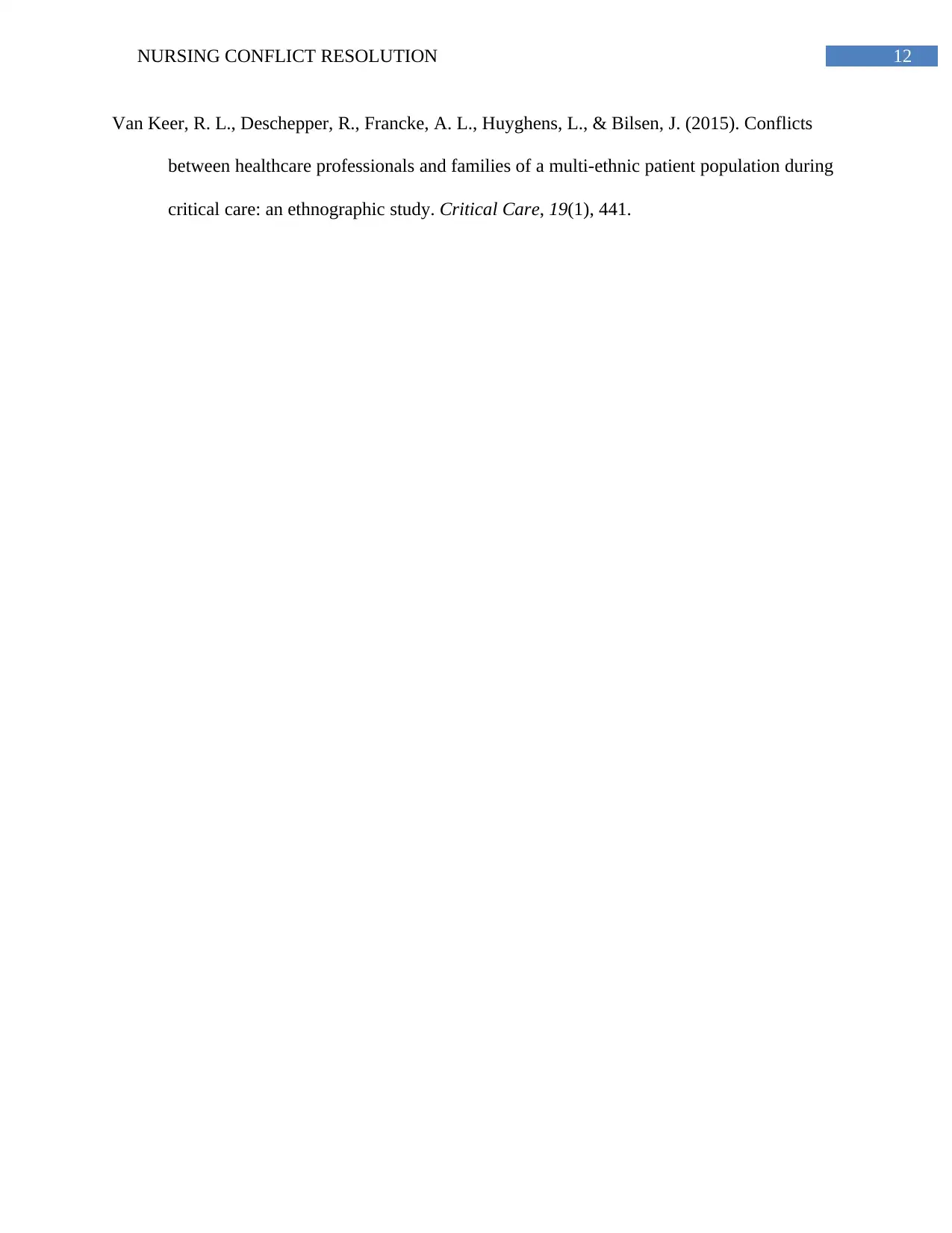
12NURSING CONFLICT RESOLUTION
Van Keer, R. L., Deschepper, R., Francke, A. L., Huyghens, L., & Bilsen, J. (2015). Conflicts
between healthcare professionals and families of a multi-ethnic patient population during
critical care: an ethnographic study. Critical Care, 19(1), 441.
Van Keer, R. L., Deschepper, R., Francke, A. L., Huyghens, L., & Bilsen, J. (2015). Conflicts
between healthcare professionals and families of a multi-ethnic patient population during
critical care: an ethnographic study. Critical Care, 19(1), 441.
1 out of 13
Related Documents
Your All-in-One AI-Powered Toolkit for Academic Success.
+13062052269
info@desklib.com
Available 24*7 on WhatsApp / Email
![[object Object]](/_next/static/media/star-bottom.7253800d.svg)
Unlock your academic potential
© 2024 | Zucol Services PVT LTD | All rights reserved.





